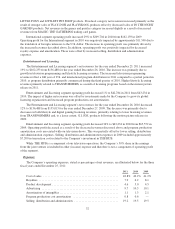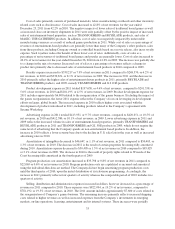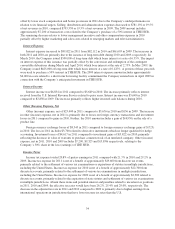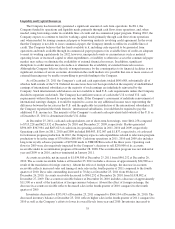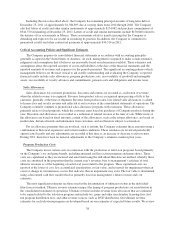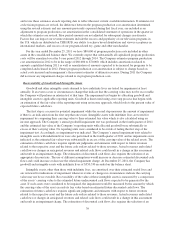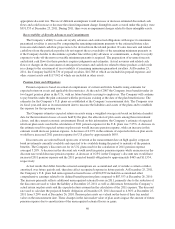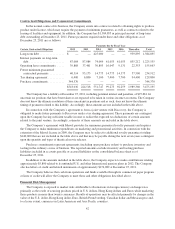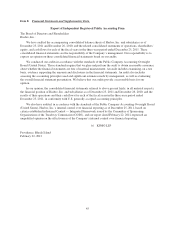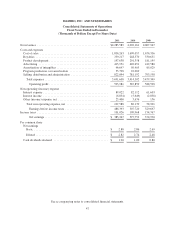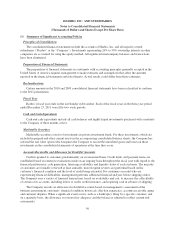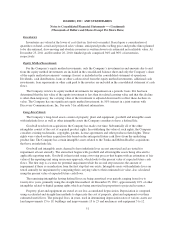Hasbro 2011 Annual Report Download - page 50
Download and view the complete annual report
Please find page 50 of the 2011 Hasbro annual report below. You can navigate through the pages in the report by either clicking on the pages listed below, or by using the keyword search tool below to find specific information within the annual report.
Income Taxes
The Company’s annual income tax rate is based on its income, statutory tax rates, changes in prior tax
positions and tax planning opportunities available in the various jurisdictions in which it operates. Significant
judgment and estimates are required to determine the Company’s annual tax rate and in evaluating its tax
positions. Despite the Company’s belief that its tax return positions are fully supportable, these positions are
subject to challenge and estimated liabilities are established in the event that these positions are challenged and
the Company is not successful in defending these challenges. These estimated liabilities are adjusted, as well as
the related interest, in light of changing facts and circumstances, such as the progress of a tax audit.
An estimated effective income tax rate is applied to the Company’s quarterly operating results. In the event
there is a significant unusual or extraordinary item recognized in the Company’s quarterly operating results, the
tax attributable to that item is separately calculated and recorded at the time. Changes in the Company’s
estimated effective income tax rate during 2011 were primarily due to changes in its estimate of earnings by tax
jurisdiction. In addition, changes in judgment regarding likely outcomes related to tax positions taken in a prior
fiscal year, or tax costs or benefits from a resolution of such positions would be recorded entirely in the interim
period the judgment changes or resolution occurs. During 2011, the Company recorded a total benefit of
approximately $29,600 related to discrete tax events, primarily related to the completion of a U.S. tax
examination.
In certain cases, tax law requires items to be included in the Company’s income tax returns at a different
time than when these items are recognized on the financial statements or at a different amount than that which is
recognized on the financial statements. Some of these differences are permanent, such as expenses that are not
deductible on the Company’s tax returns, while other differences are temporary and will reverse over time, such
as depreciation expense. These differences that will reverse over time are recorded as deferred tax assets and
liabilities on the consolidated balance sheet. Deferred tax assets represent deductions that have been reflected in
the financial statements but have not yet been reflected in the Company’s income tax returns. Valuation
allowances are established against deferred tax assets to the extent that it is determined that the Company will
have insufficient future taxable income, including capital gains, to fully realize the future deductions or capital
losses. Deferred tax liabilities represent expenses recognized on the Company’s income tax return that have not
yet been recognized in the Company’s financial statements or income recognized in the financial statements that
has not yet been recognized in the Company’s income tax return. The Mexican government has a tax structure
which results in companies paying the higher of an income-based tax or an alternative flat tax. Should the
Company be subject to the alternative flat tax, it would be required to review whether its net deferred tax assets
would be realized. As the Company believes that it will continue to be subject to the income-based tax in 2012, it
believes that the net deferred tax assets related to the Mexican tax jurisdiction will be realizable. Should the facts
and circumstances change, the Company may be required to reevaluate deferred tax assets related to its Mexican
operations, which may result in additional tax expense.
Recent Accounting Pronouncements
In June 2011, the Financial Accounting Standards Board (“FASB”) issued Accounting Standards Update
No. 2011-05, Presentation of Comprehensive Income, which will require companies to present the components of
net income and other comprehensive earnings either in a single continuous statement or in two separate but
consecutive statements. It eliminates the option to present components of other comprehensive earnings as part of
the statement of changes in shareholders’ equity. The pronouncement does not change the current option for
presenting components of other comprehensive earnings, gross or net of the effect of income taxes, provided that
such effects are presented in the statement in which other comprehensive earnings are presented or disclosed in
the notes to the financial statements. Additionally, the pronouncement does not affect the calculation or reporting
of earnings per share. The pronouncement also does not change the items which must be reported in other
comprehensive earnings, how such items are measured or when they must be reclassified to net earnings. This
standard is effective for reporting periods beginning after December 15, 2011. Early application is permitted.
Hasbro expects its adoption will have no effect on its financial position or results of operations but it will impact
the way Hasbro presents comprehensive earnings.
41



